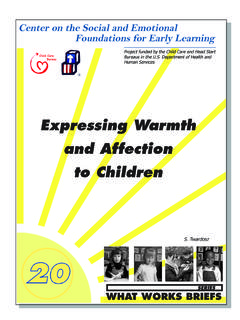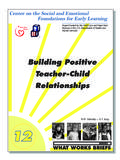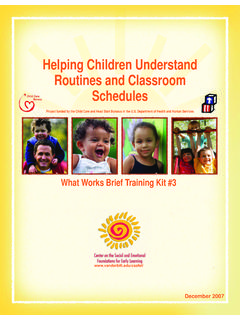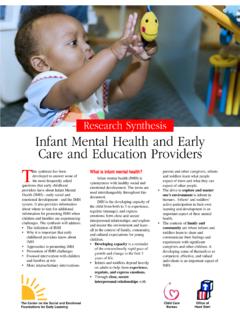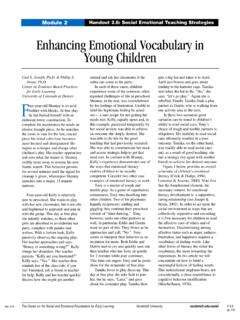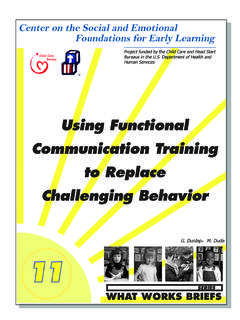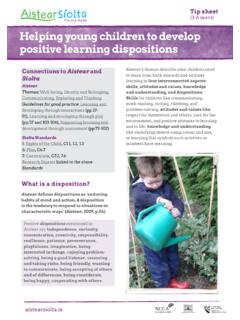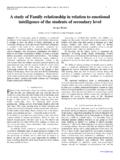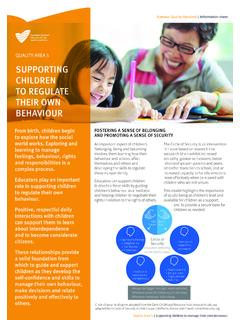Transcription of Inventory of Practices for Promoting Social Emotional ...
1 Inventory of Practices for Promoting Social Emotional Competence Inventory of Practices for Promoting children 's Social Emotional Competence Center on the Social and Emotional Foundations for Early Learning Purpose of the Inventory : The Inventory of Practices for across the three levels, Consistently, Occasionally, and Seldom ( , across Promoting Social Emotional Competence is designed to be used by all children in the classroom, target child or specific groups of children , individuals and/or teams to identify training needs and plan a environment of all classrooms, etc.). The final column allows the team to course of action to address those needs related to four general indicate whether or not an indicator should be a Target for Training.
2 Areas: (a) building positive relationships, (b) creating supportive Following each section is a space for writing additional comments. The environments, (c) Social Emotional teaching strategies, and (d) team or individual may wish to delineate specific training requests, profes- individualized intensive interventions. The Inventory encourages sional development opportunities, or encouragement in the Comments individual self-reflection, opportunities for teaming between class- box. room teachers, mentor coaches, supervisors, site directors, and other administrators, and promotes effective Practices for direct Use of the Action Plan: The Action Plan takes the users to the next step service staff.
3 There are two sections to this tool: the Inventory of once they have determined what specific Skills and Indicators from the Practices and the Action Plan. Inventory they want to target for training. In the first column of the Action Plan, users should check those Skills or Indicators they previously Use of the Inventory : This tool is best utilized in a manner that identified as targets for training. In the second column, teachers and encourages reflection and discussion. Each of the four general support personnel ( , trainers, mentor coaches, administrators) should areas includes several Skills and Indicators reflective of Practices work together to identify what strategies they will each use to help the that promote Social Emotional competence in young children .
4 The teaching team implement the new Practices . The third column allows users Indicators are detailed phrases that enable the user to dig a little to identify Resources and Supports that will be necessary to successfully deeper in identifying and pinpointing skills that may or may not be complete the activities or strategies listed in the second column. present. A column entitled Observations/Evidence allows the user to write thoughts, suggestions, strengths, and needs concerning Completion Dates: Users may complete the Inventory and Action Plan at either the specific Skills or Indicators.
5 Three levels of skill, different times as a way of determining their progress toward addressing Consistently, Occasionally, and Seldom, permit users to record their specific skills targeted for training. Different color inks corresponding to perceived skill level for each Indicator by checking the appropriate the dates completed can be used when completing the tool in order to box. Users should be consistent in their appraisal of skills highlight changes over time. 2/10 The Center on the Social and Emotional Foundations for Early Learning Vanderbilt University H1/4. P. 1/28. Inventory of Practices for Promoting Social Emotional Competence Building Positive Relationships Occasionally Consistently Skills and Indicators Target for Observations/Evidence Seldom training?
6 1. Develops meaningful relationships with children and families 3 2 1 YES NO. Greets children on arrival; calls by name Communicates with children at eye level Verbally interacts with individual children during routines and activities Participates in children 's play when appropriate Shows respect, consideration, warmth to all children Speaks calmly to children Uses a variety of strategies for building relationships with all children Attends to children in positive ways at times when the children are not engaging in challenging behavior Uses a variety of strategies for building relationships with all families Creates a classroom that is a place that children and families like to be (.)
7 Feel comfortable, welcome, and safe). Comments: 2. Examines personal, family, and cultural views of child's 3 2 1 YES NO. challenging behavior Considers personal beliefs regarding the acceptability and unacceptability of specific types of child behavior Considers personal beliefs regarding the causes of specific types of unacceptable child behavior Acknowledges contrasting or conflicting beliefs held by others regarding acceptable and unacceptable types of child behavior Comments: Date 1 Completed: _____ Date 2 Completed: _____. 2/10 The Center on the Social and Emotional Foundations for Early Learning Vanderbilt University P.
8 2/28. Inventory of Practices for Promoting Social Emotional Competence Building Positive Relationships Occasionally Consistently Skills and Indicators Target for Observations/Evidence Seldom training? 3. Examines own attitudes toward challenging behavior 3 2 1 YES NO. Understands the relationship between children 's Social Emotional development and challenging behaviors Understands that children 's challenging behaviors are conveying some type of message Understands there are many things that can be done to prevent challenging behaviors Identifies what behaviors push my buttons . Develops strategies for dealing with situations when children 's behaviors push my buttons.
9 Works together with a team to problem solve around issues related to challenging behaviors Comments: Date 1 Completed: _____ Date 2 Completed: _____. 2/10 The Center on the Social and Emotional Foundations for Early Learning Vanderbilt University P. 3/28. Inventory of Practices for Promoting Social Emotional Competence Designing Supportive Environments Occasionally Consistently Skills and Indicators Target for Observations/Evidence Seldom training? 4. Designs the physical environment 3 2 1 YES NO. Arranges traffic patterns in classroom so there are no wide open spaces Removes obstacles that make it difficult for children with physical disabilities to move around the room Clearly defines boundaries in learning centers Arranges learning centers to allow room for multiple children Provides a variety of materials in all learning centers Designs learning centers so that children spend time evenly across centers Considers children 's interests when deciding what to put in learning centers Makes changes and additions to learning centers on a regular basis Visually closes learning
10 Centers when they are not an option for children to use Comments: 5. Develops schedules and routines 3 2 1 YES NO. Designs schedule to include a balance of large group and small group activities Designs schedule to minimize the amount of time children spend making transitions between activities Implements schedule consistently Teaches children about the schedule Provides explanations when changes in the schedule are necessary Comments: Date 1 Completed: _____ Date 2 Completed: _____. 2/10 The Center on the Social and Emotional Foundations for Early Learning Vanderbilt University P. 4/28.

